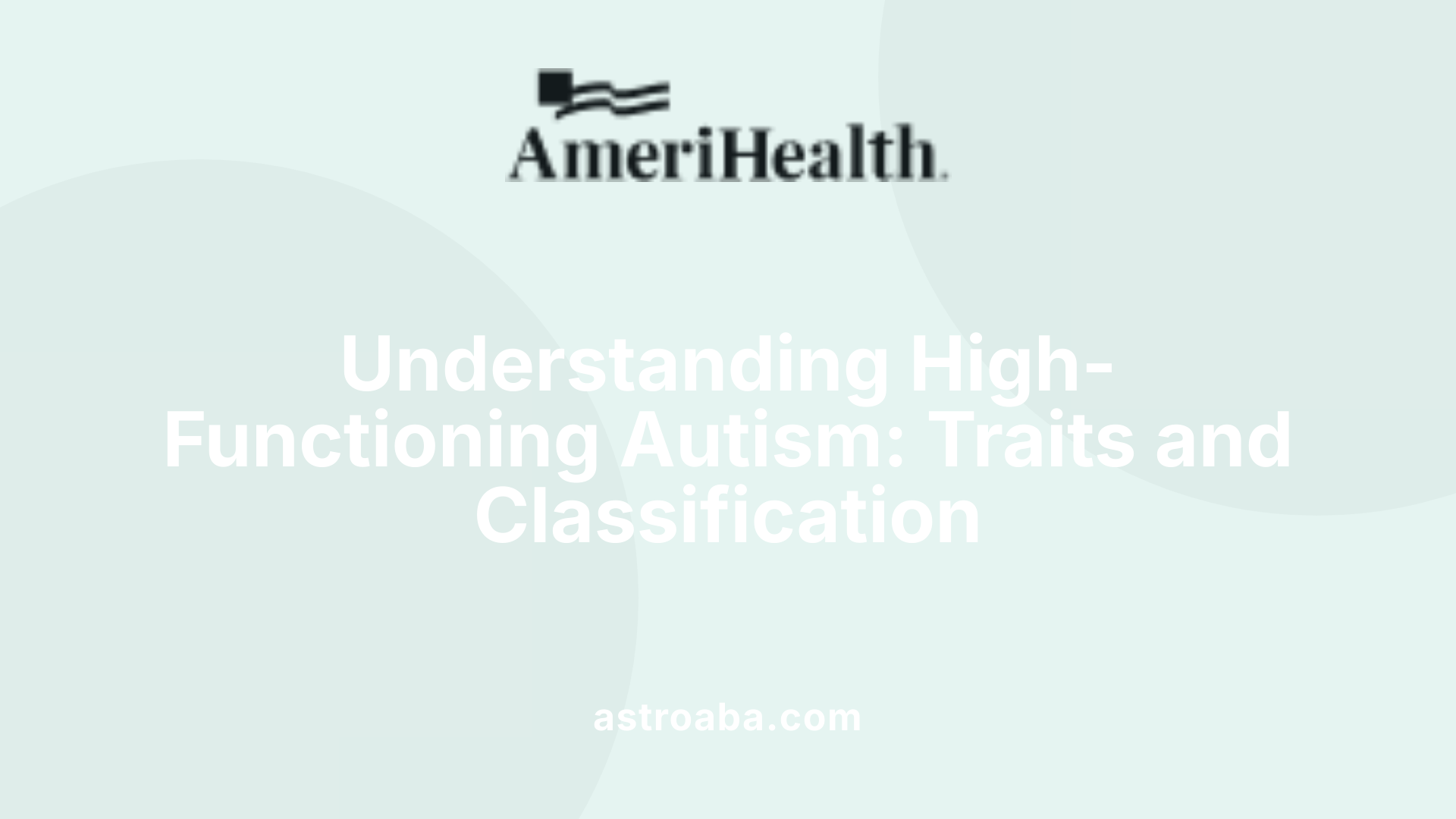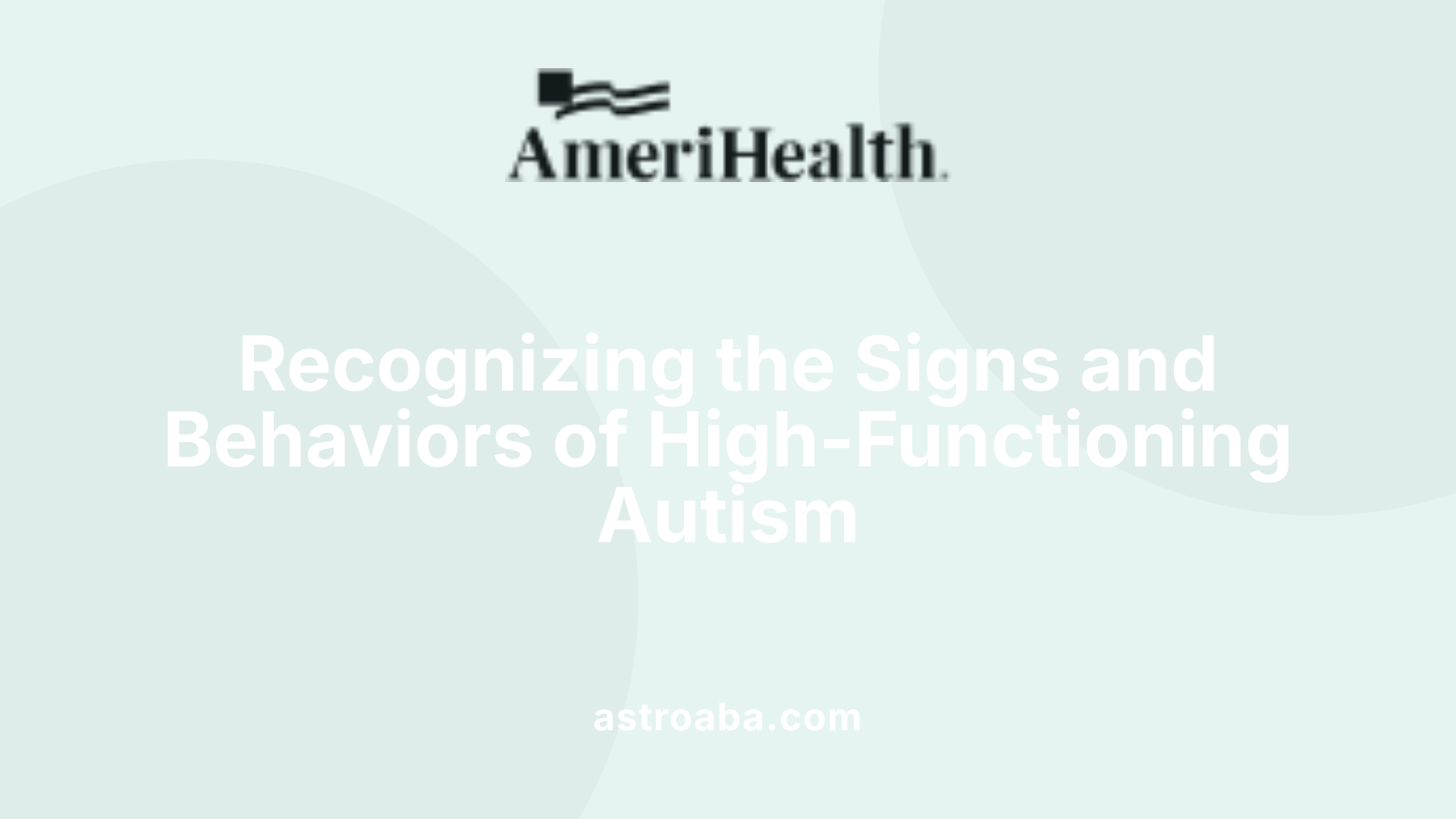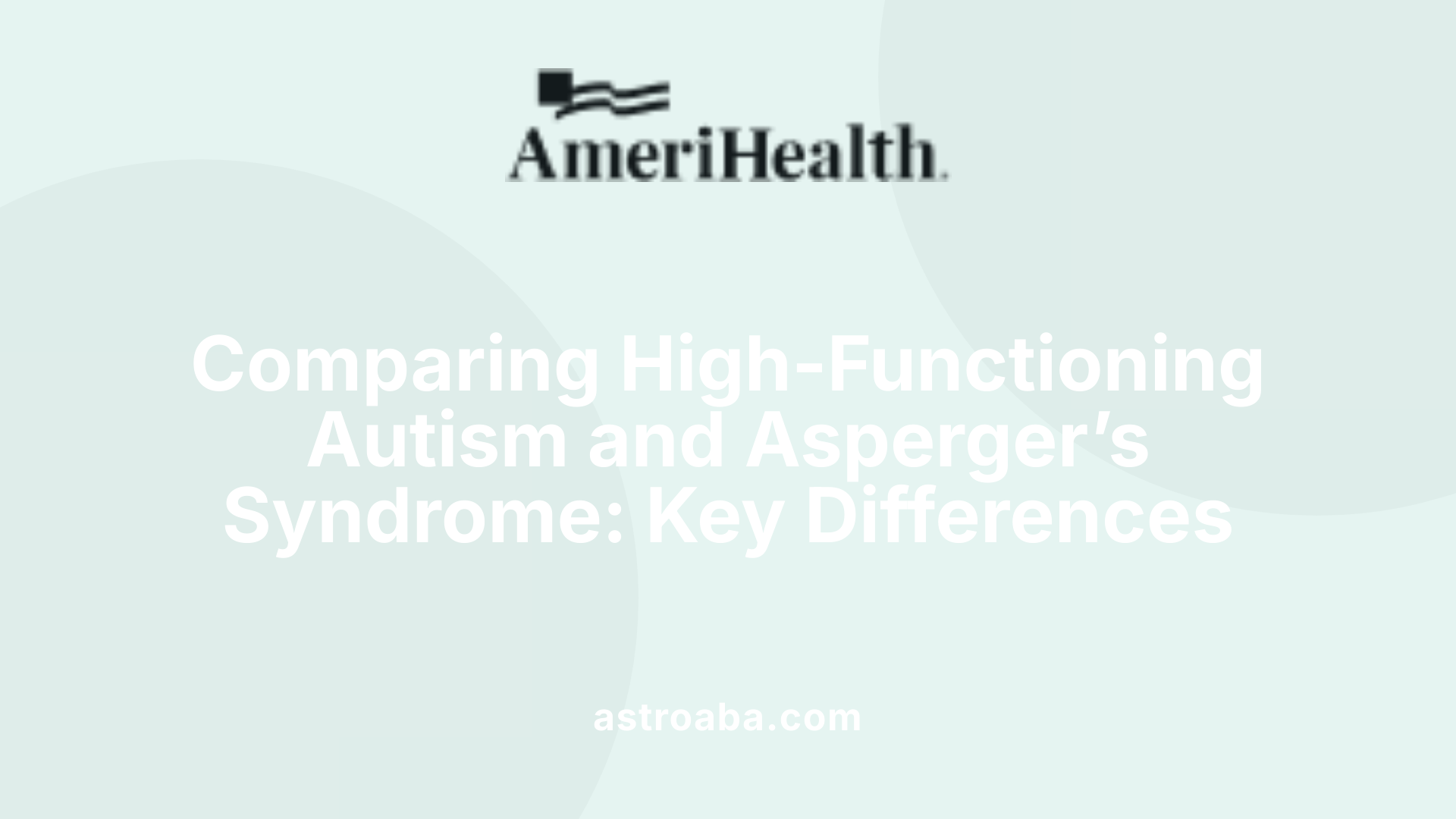High-Functioning Autism
Understanding the Spectrum of High-Functioning Autism

An Insight into Autism Spectrum Variability
High-functioning autism (HFA) is a term widely used to describe individuals on the autism spectrum who demonstrate average or above-average intelligence and possess strong language skills, often enabling independent living with minimal support. This article explores the complex landscape of HFA, including its characteristics, diagnosis, misconceptions, and support mechanisms, emphasizing the importance of viewing autism as a spectrum with diverse strengths and challenges.
Defining High-Functioning Autism within the Autism Spectrum

What is high-functioning autism?
High-functioning autism is an informal term used to describe individuals on the autism spectrum who have average or above-average intelligence, strong language skills, and the ability to live independently with minimal support.
It typically refers to those classified as level one on the autism severity scale, meaning they require some support but can manage daily activities and have relatively fewer challenges with communication and social interactions.
While often associated with traits like a strong focus on routines, restricted interests, and difficulties reading social cues, high-functioning autism is not an official diagnosis and is sometimes criticized for oversimplifying individual experiences.
The term originated in the 1990s and was historically linked to diagnoses like Asperger’s syndrome, which has since been subsumed under autism spectrum disorder in recent classification systems.
Overall, it is important to recognize the diverse needs and abilities of autistic individuals, rather than relying solely on labels like "high-functioning."
Signs, Symptoms, and Behavioral Traits of High-Functioning Autism

What are the common symptoms and behaviors of high-functioning autism?
Individuals with high-functioning autism often display a unique set of behaviors and traits that distinguish them within the autism spectrum. Commonly, they face difficulties in social interaction, such as trouble reading social cues, making eye contact, and initiating conversations. They may find it challenging to understand humor, sarcasm, or idiomatic language, which can sometimes lead to misunderstandings.
Many exhibit intense, focused interests or hobbies, often obsessively exploring specific topics. Repetitive behaviors and routines are prevalent; they might insist on strict adherence to routines and become distressed by changes. sensory sensitivities are also typical, with some being overly sensitive to lights, sounds, or textures, which can cause discomfort or sensory overload.
Communication challenges include a monotone voice, limited use of gestures, and difficulty maintaining engaging conversations. Emotional regulation is often a struggle—these individuals might experience heightened anxiety and have trouble managing emotions, leading to withdrawal or shutdowns when overwhelmed.
Despite these difficulties, most with high-functioning autism excel academically or professionally. They can read, write, speak, and manage daily life skills effectively, often leading independent lives. Recognizing these behaviors can support understanding and foster appropriate support strategies, ensuring individuals reach their full potential.
Diagnosis and Support Strategies for High-Functioning Autism

How is high-functioning autism diagnosed?
High-functioning autism (HFA) is not a formal medical diagnosis but commonly refers to individuals on the autism spectrum who have adequate communication skills, intellectual abilities, and the capacity to live independently. The process of diagnosing autism spectrum disorder (ASD), including those considered high-functioning, involves detailed and comprehensive evaluations by healthcare professionals.
The diagnosis is primarily based on the criteria set out in the DSM-5, which focus on persistent challenges in social communication and interaction, alongside restricted and repetitive behaviors. Clinicians conduct thorough developmental histories, observe behaviors, and use standardized assessment tools such as the Autism Diagnostic Observation Schedule (ADOS) and the Autism Diagnostic Interview-Revised (ADI-R).
Parents and caregivers often provide valuable insights through interviews about childhood development, social skills, and behavioral patterns. These assessments aim to identify symptoms that were present early in life, cause significant impairment in daily functioning, and are not better explained by other intellectual or developmental disabilities.
While the term 'high-functioning autism' is commonly used, it remains subjective and somewhat controversial because it emphasizes support needs rather than the broad spectrum of individual abilities and challenges. Increasingly, the focus in clinical practice has shifted toward viewing autism as a spectrum, acknowledging diversity rather than relying on fixed labels based on functioning levels. Support and intervention strategies are then tailored to each person's unique profile, considering their strengths, difficulties, and personal goals.
In summary, diagnosis involves a blend of behavioral observation, developmental history, and standardized testing, aiming to understand each individual's social and behavioral profile. This thorough process helps clinicians recommend appropriate therapies, educational support, and coping strategies to improve the person’s quality of life.
Differences Between High-Functioning Autism and Asperger’s Syndrome

Developmental milestones and language skills
Individuals with high-functioning autism (HFA) often experience delays in developmental milestones such as speech. They may begin speaking later than typical, and their language skills can be less developed compared to their peers. These children might also have difficulty with pragmatic language use, like understanding jokes, sarcasm, or social cues.
In contrast, those previously diagnosed with Asperger’s syndrome tend to have normal or even advanced language skills. They usually develop language on time, and their speech patterns are often typical. However, they might have trouble understanding social nuances despite their good verbal abilities.
Severity of social difficulties
Both groups face social challenges, but the severity and presentation can differ. People with HFA often display more noticeable social impairments, struggling to interpret social cues and maintain relationships. They may appear more withdrawn or awkward in social settings.
Individuals with Asperger’s syndrome typically have milder social difficulties. They may have a good vocabulary and conversational skills but still find it hard to grasp social norms or read between the lines. Consequently, they can sometimes mask their struggles better than those with HFA.
Classification history and current understanding
Historically, Asperger’s syndrome was considered a separate condition characterized by average or above-average intelligence and no significant language delay. It was seen as a milder form of autism.
However, in 2013, the American Psychiatric Association integrated Asperger’s into autism spectrum disorder (ASD) under the DSM-5. Now, both are seen as part of a spectrum, with individuals placed along a continuum based on support needs and symptom severity.
HFA is informally used to describe those who require minimal support and have relatively mild symptoms, similar to what was once labeled as Asperger’s. Both are now classified within ASD Level 1, which entails requiring support but functioning relatively independently.
Understanding these differences helps in tailoring intervention strategies and setting appropriate expectations. Nonetheless, since both conditions share core features—social difficulties, restricted behaviors, and sensory sensitivities—they are best viewed as points along a diverse spectrum rather than entirely separate disorders.
Myths, Misconceptions, and Realities of High-Functioning Autism
Are there common misconceptions about high-functioning autism?
A widespread misunderstanding about high-functioning autism is the belief that all individuals with this label are alike and do not need support. In fact, those categorized under this term have a wide range of strengths, challenges, and specific needs. Some assume that high-functioning autism means the person has no difficulties or does not require assistance, but many still face significant social, sensory, and behavioral hurdles.
Another common myth is that autism stems from poor parenting or is vaccine-induced. Both claims have been thoroughly debunked by reputable scientific research, which confirms autism as a neurodevelopmental condition present from early childhood, unrelated to parenting choices or vaccination status.
It is also frequently believed that autistic individuals lack empathy or social skills, but this is not true. Many experience and express emotions in complex ways, can form deep relationships, and have their own social understanding, even if it differs from neurotypical social norms. Some people think autism can be "cured," but this misconception overlooks the fact that autism is a lifelong spectrum of neurodiversity.
Most importantly, there is a tendency to underestimate what autistic individuals are capable of achieving. Many with high-functioning autism lead independent lives, excel in careers, have meaningful relationships, and possess talents that contribute to society. Understanding and dispelling these myths are crucial for fostering acceptance and providing appropriate support for autistic individuals.
Strengths, Challenges, and Neurophysiological Insights
What are the strengths and challenges associated with high-functioning autism?
High-functioning autism (HFA) is often associated with notable strengths such as a keen attention to detail, excellent memory skills, strong pattern recognition, and deep focus on specific interests. These abilities can lead to talents in fields like art, music, mathematics, and systematization, allowing individuals to excel academically or professionally in specialized areas.
However, HFA individuals also face particular challenges. Difficulties in social communication are common, including struggles with reading social cues, understanding sarcasm, and maintaining eye contact. Sensory sensitivities—being overwhelmed by bright lights, loud noises, or textures—are also prevalent and can impact daily functioning. Additionally, rigid routines, repetitive behaviors, and environmental changes can cause distress.
These behavioral patterns are often linked to deficits in executive functioning—the brain's ability to plan, organize, and adapt. Despite these hurdles, many with HFA thrive in structured settings and benefit greatly from early interventions, social skills training, and supportive environments. Recognizing and cultivating their unique strengths fosters greater confidence and improves overall quality of life.
Towards a Supportive and Inclusive Understanding of Autism
Recognizing high-functioning autism within the spectrum emphasizes the importance of individualized support and understanding. Moving away from outdated labels and stereotypes, a focus on specific strengths, challenges, and personal needs allows for more meaningful assistance and acceptance. Early diagnosis and tailored interventions can significantly enhance quality of life, enabling individuals to utilize their talents and navigate social environments with greater ease. Promoting awareness, debunking myths, and appreciating the diversity of experiences across the autism spectrum will foster a more inclusive society where all individuals are valued for their unique contributions.
References
- High-Functioning Autism: What Is It and How Is It Diagnosed?
- High-functioning autism - Wikipedia
- High Functioning Autism Checklist - thriving wellness center
- What 'High-Functioning Autism' Means (and Why You Shouldn't Call ...
- What Is High-Functioning Autism? - Child Mind Institute
- What Is High-Functioning Autism? - Special Olympics Arizona
- Clinical characteristics of high-functioning youth with autism ...
- Autism spectrum disorder - Symptoms and causes - Mayo Clinic
Recent articles

The Role of Prompting and Fading in ABA Therapy Programs
Enhancing Autism Interventions Through Systematic Support Reduction

The Role of ABA Therapy in Supporting Community Participation
Enhancing Lives Through Community-Focused ABA Interventions

The Role of ABA Therapy in Encouraging Initiative and Motivation
Unlocking Potential: How ABA Empowers Children to Take Initiative

How ABA Therapy Helps Children Develop Initiation and Motivation
Unlocking Potential: The Power of ABA in Fostering Child Independence

How ABA Therapy Encourages Participation in Cooperative Group Activities
Fostering Social Skills Through ABA Interventions

How ABA Therapy Supports Independent Task Initiation in Children
Empowering Children to Begin with Confidence

How ABA Therapy Helps Children Build Resilience in Challenging Situations
Building Emotional Strength Through ABA Therapy

The Impact of ABA Therapy on Reducing Anxiety in Social Settings
Transforming Social Experiences: How ABA Therapy Eases Autism-Related Anxiety

Strategies for Teaching Self-Monitoring Through ABA
Empowering Independence: Techniques to Foster Self-Monitoring with ABA

The Benefits of Combining ABA with Speech and Language Therapy
Integrating Treatment Approaches to Maximize Developmental Progress

Strategies for Teaching Cooperative Problem-Solving Through ABA
Enhancing Collaborative Skills with ABA: Proven Strategies and Techniques

How ABA Therapy Encourages Independent Participation in Daily Tasks
Empowering Autonomy: How ABA Therapy Builds Independence in Daily Life

Creating an Effective Learning Environment at Home for ABA Therapy
Building a Supportive Home Environment for ABA Success

How ABA Therapy Encourages Following Safety Rules at Home and School
Empowering Children with Autism to Follow Essential Safety Rules

How ABA Therapy Encourages Communication Using Gestures and Signs
Enhancing Social Skills with Targeted Gesture Teaching

Common ABA Therapy Techniques for Reducing Aggression
Innovative Strategies in ABA to Minimize Aggressive Behaviors

How ABA Therapy Encourages Communication Using Gestures and Signs
Unlocking the Power of Gestures and Signs in Autism Therapy

How ABA Therapy Encourages Appropriate Social Greetings
Enhancing Social Skills Through Evidence-Based Interventions

Addressing Social Anxiety Using ABA-Based Techniques
Harnessing ABA to Alleviate Social Anxiety

Famous Politicians With Autism
Celebrating Neurodiversity: Insights into Autism and Notable Figures

How ABA Therapy Can Help with Anxiety in Children with Autism
Unlocking Emotional Well-Being: The Power of ABA in Managing Autism-Related Anxiety

The Impact of ABA Therapy on School Success
Enhancing Educational Outcomes with Systematic Interventions

The Importance of Social Stories in ABA Therapy
Harnessing Social Stories to Enhance Social Skills in Autism Interventions

Mild Autism
Understanding the Nuances of Mild Autism

What Are Functional Behavior Assessments (FBA) in ABA Therapy?
Unlocking the Secrets Behind Behavior: The Power of FBAs in ABA

Early Signs Of Autism In Babies And Kids
Recognizing Early Indicators to Support Developmental Health

How to Find Funding for ABA Therapy Services
Unlocking Funding Opportunities for Autism Treatments

How to Help a Child with Autism Transition to ABA Therapy
Supporting Children Through Transition Phases in ABA Therapy

Do Autistic People Get Injured More?
Examining Injury Risks in Individuals with Autism Spectrum Disorder

How ABA Therapy Can Help with Executive Functioning Challenges
Unlocking Skills: The Impact of ABA on Executive Functioning in Autism

What is the Premack Principle in ABA Therapy?
Unlocking Motivation: The Power of the Premack Principle in ABA Therapy

Low-Functioning Autism
Understanding the Challenges and Supports for Low-Functioning Autism

Low-Functioning Autism
Understanding the Challenges and Supports for Low-Functioning Autism

How ABA Therapy Can Help with Playdates and Social Events
Unlocking Social Success: How ABA Therapy Facilitates Playdates and Community Engagement

How ABA Therapy Can Address Impulse Control Issues
Mastering Behavioral Growth: The Power of ABA in Impulse Control

Book, Movie, and TV Characters on the Autism Spectrum
Enhancing Understanding Through Fictional Portrayals

Book, Movie, and TV Characters on the Autism Spectrum
Enhancing Understanding Through Fictional Portrayals

The Role of Visual Supports in ABA Therapy
Enhancing Autism Interventions with Visual Supports

What Is Pervasive Developmental Disorder
Understanding the Spectrum of Developmental Challenges

How ABA Therapy Helps with Emotional Regulation
Empowering Emotional Resilience in Children with Autism

What is Task Analysis in ABA Therapy?
Unveiling the Foundations of Task Analysis in ABA Therapy

How ABA Therapy Can Improve Play Skills
Unlocking Growth: The Power of ABA in Enhancing Play Skills

Air Pollution and Autism
Unveiling the Environmental Impact on Developing Minds

How ABA Therapy Can Help with Bullying Prevention
Building Respect and Resilience Through ABA

How ABA Therapy Can Be Used to Teach Problem-Solving Strategies
Empowering Individuals with Autism Through Targeted Problem-Solving Skills

Can Autistic People Work?
Unlocking Potential: The Realities of Employment for Autistic Individuals

How ABA Therapy Can Help with Homework and Academics
Empowering Academic Success with ABA Therapy

Common Myths About ABA Therapy Debunked
Unmasking Autism Treatment: The Truth About ABA Therapy

Does Aluminum Cause Autism?
Unraveling the Link: Aluminum and Autism Spectrum Disorder

How ABA Therapy Can Support Emotional Expression and Understanding
Unlocking Emotional Growth in Autism Through ABA Therapy

The Role of ABA Therapy in Helping Children Learn Road Safety
Empowering Safe Journeys: How ABA Therapy Fosters Road Safety Skills in Children

The Role of Group ABA Therapy in Social Development
Enhancing Social Skills Through Collective Strategies

What Is Autistic Burnout?
Understanding the Hidden Struggle of Autistic Burnout

How Do You Get An Autistic Child To Keep Their Shoes On?
Mastering Comfort and Compliance with Shoes for Autistic Children

The Role of ABA Therapy in Addressing Food Aversions and Picky Eating
Transforming Mealtimes: How ABA Therapy Supports Children with Autism

How ABA Therapy Can Assist in Reducing Perfectionism and Anxiety
Harnessing Behavioral Science to Ease Perfectionism and Anxiety

What Is Defeat Autism Now?
Unveiling the Roots and Realities of the DAN Movement

How ABA Therapy Can Help Children Develop Conflict Resolution Skills
Building Bridges: Empowering Children with Conflict Resolution Skills through ABA

OCD vs. Autism
Unraveling the Complex Relationship Between OCD and Autism

Temper Tantrums A Sign Of Autism
Understanding the Complex Relationship Between Temper Tantrums and Autism Spectrum Disorder

How to Pass the BCBA Exam
Your Ultimate Guide to Success in the BCBA Exam

Autism and Addiction's Close Connection
Unraveling the Complex Interplay Between Autism and Substance Use

Autism Facial Expressions
Decoding Emotions: The Complex World of Facial Expressions in Autism

How ABA Therapy Can Help Reduce Anxiety Around Doctor and Dentist Visits
Transforming Medical Experiences for Children with Autism

How ABA Therapy Can Help with Navigating Social Media Responsibly
Empowering Safe Online Engagement for Children with Autism through ABA

How to Choose an Autism Charity
Navigating the Spectrum of Support: A Guide to Selecting the Right Autism Charity

What is Precision Teaching in ABA Therapy?
Harnessing Data-Driven Strategies for Skill Mastery

Autism and Obesity
Understanding the Overlap: Autism and the Rising Concern of Obesity

Individualized Education Programs (IEPs) for Autism
Supporting Success: A Comprehensive Guide to IEPs for Children with Autism

How to Integrate ABA Therapy into Everyday Routines
Transforming Daily Life with ABA Strategies

What is Shaping in ABA Therapy?
Understanding the Core of Behavior Shaping in Autism Interventions

Autism vs. ADHD
Understanding the Distinction and Overlap of Neurodevelopmental Disorders

Is RBT Certification Worth It?
Unveiling the Value of RBT Certification in the Field of ABA

How Negative Reinforcement Works in ABA Therapy
Unlocking the Power of Negative Reinforcement in Behavioral Therapy

How to Advocate for ABA Therapy Services in Schools
Navigating Advocacy for School-Based ABA Therapy

How ABA Therapy Can Address Impulsivity in Children
Transforming Child Behavior: The Power of ABA Therapy Against Impulsivity

Understanding the Different Types of ABA Therapy Programs
Exploring the Spectrum of ABA Therapy Approaches

How ABA Therapy Can Address Regression in Autism
Understanding Regressive Autism and the Role of ABA Therapy

High Functioning Autism And Anger
Understanding Emotional Challenges in High-Functioning Autism

Autism and Puberty
Understanding Puberty in Autistic Youth: Challenges and Support Strategies

Challenging Autism Behavior Problems
Navigating the Complex Landscape of Autism-Related Behavioral Challenges

How ABA Therapy Can Help with Sleep Problems
Transforming Bedtime Routines with Evidence-Based Approaches

How ABA Therapy Can Help Improve Cooperation and Compliance
Fostering Respectful Engagement: The Role of ABA in Enhancing Cooperation and Compliance

Eating Disorders And Autism
Unraveling the Complex Relationship Between Autism and Eating Disorders

How Schedules of Reinforcement Work in ABA Therapy
Mastering Reinforcement Patterns to Foster Behavior Change

How to Incorporate ABA Therapy into a Homeschooling Program
Transforming Homeschooling with Evidence-Based Strategies

What Are the Most Common Misconceptions About ABA Therapy?
Unveiling the Truth Behind ABA Therapy: Myths vs. Facts

What is Demand Fading in ABA Therapy?
Demystifying Demand Fading in ABA Therapy

What Are ABA Assessments and How Do They Work?
Understanding the Foundations of ABA Assessments

What is an AAC Device for Autism?
Unlocking Communication: The Power of AAC Devices for Autism

How ABA Therapy Can Help Children Understand and Express Emotions
Enhancing Emotional Understanding Through Evidence-Based Interventions

How To Prevent Autism
Emerging Strategies to Reduce Autism Risk in Children

How ABA Therapy Can Improve Verbal and Nonverbal Communication
Unlocking Communication: The Power of ABA Therapy for Children with Autism

Natural Environment Teaching (NET): How It Helps with Skill Generalization
Unlocking Practical Learning in Natural Settings

What Is Play Therapy For Autism?
Unlocking the Potential of Play in Autism Therapy

How ABA Therapy Can Improve Fine and Gross Motor Skills
Enhancing Movement and Independence Through ABA Strategies

Calming Strategies For Kids With Autism
Understanding and Supporting Calmness in Children with Autism

Autism Evaluation
Comprehensive Insights into Autism Assessment and Diagnosis

How to Support Your Child's ABA Therapy at Home
Empowering Your Child’s Development at Home with ABA Support

Autism Prevalence Increases in Arizona
Rising Autism Rates Signal Changing Landscape in Arizona

